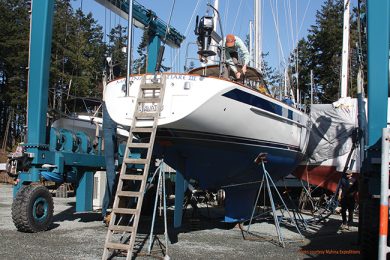One of the easiest sail trimming mistakes to avoid is over-sheeting. Simply remember the phrase, “When in doubt, let it out.” Let the sheet out until the sail just begins to luff and then bring it in until it stops. But what happens if part of the sail is set perfectly but another part of it is luffing? That is a good indication that your sheet lead needs to be adjusted.
The block that turns your headsail sheet on its way to your winch can be moved to improve your sail shape and performance. At the simplest level, what you are trying to do is bisect the angle that is formed at the clew of your sail. If you were to follow the line your sheet creates upward onto the sail, it should split the clew angle in half.
You will know you have the sheet lead correct when the leech and the foot of the sail both break, or start to luff, at the same time. This is an indication that the sheet is pulling equally on the leech and the foot. If the foot of the sail breaks first, you need to move the sheet lead aft so that it is pulling more directly on the foot to prevent it from luffing. Similarly, if the leech of the sail luffs before the foot, the sheet lead needs to be moved forward to pull down more on the leech.
 Once you get the sheet lead perfect, however, your work is not done. The sheet lead will need to be adjusted with each different headsail, of course, but it will also need to be changed if you fly the headsail slightly furled. This alters the shape of the sail, moving the clew, and therefore requiring a change in the sheet lead. Generally speaking, a slightly furled headsail will need the sheet lead moved forward to accommodate this change in the direction of the angle of the clew.
Once you get the sheet lead perfect, however, your work is not done. The sheet lead will need to be adjusted with each different headsail, of course, but it will also need to be changed if you fly the headsail slightly furled. This alters the shape of the sail, moving the clew, and therefore requiring a change in the sheet lead. Generally speaking, a slightly furled headsail will need the sheet lead moved forward to accommodate this change in the direction of the angle of the clew.
There are times when we do not want the sheet pulling equally on the leech and the foot. When sailing off the wind, for example, it is best to put a little “belly” in the sail, to let the foot out farther. This can be accomplished by moving the sheet lead forward, which pulls on the leech but allows the foot to be a bit slack and hold more wind. When sailing closer to the wind, you will want to flatten the sail to give it more upwind power. To do this, adjust the sheet lead so that the foot is being pulled tight and flattened. This means moving the sheet lead aft.
When we trim our headsail and either the foot or the leach sets nicely but the other is still luffing, rather than pulling the sail in more, we know that the sheet lead needs to be adjusted. That is the easiest way to avoid being guilty of over-sheeting.
Connie McBride, her husband and their three sons sailed away on their 34-foot Creekmore in 2002. Since then, they have explored much of the Caribbean. You can read about their adventures in Panama in Connie’s new book: Eurisko Sails West: A Year in Panama, available at Amazon and on her site www.simplysailingonline.com.















